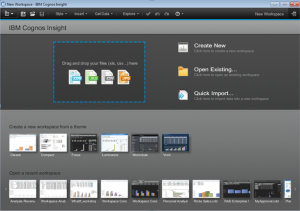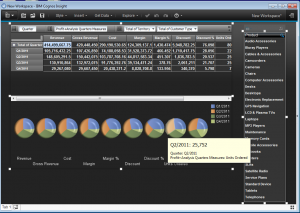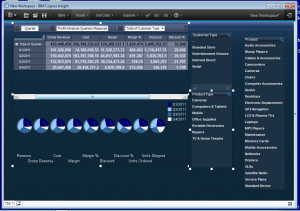Data governance is a common need across organizations, and can be a very challenging subject to tackle. Understanding data governance’s components, what good governance looks like, and the drivers behind adopting it is essential to creating a successful governance effort. Read more
Tag Archive for: Data Discovery
As we’ve mentioned before, as of April 2018 there will be limited extended support for Cognos 10.x. Sure, that sounds like a long time from now, but if there’s anything I’ve learned from my time in enterprise IT, it’s that making a change is like turning a battleship. You need to start actively planning for it and plotting your course way ahead of time to ensure everything runs smoothly. Read more
LEXINGTON, Mass., Dec. 12, 2016 /PRNewswire/ — Ironside, a Boston-based data and analytics firm, just released an authoritative list of questions that they recommend business leaders try to answer now in planning for their analytics initiatives.
Today, it’s safe to say that the majority of businesses understand the value of analytics. They get that their data is important and that using it in the right way can have significant benefits. The problem, though, is that even though the business community as a whole acknowledges these facts, there’s still a lot of magical thinking around analytics tools and platforms out there. Read more
If modern business data is a river, then traditional enterprise business intelligence is a bucket. Sure, you can pull some valuable and reliable insights at regular intervals that will help you take the pulse of what’s going on day to day, but there’s a much larger percentage of valuable insight that’s just going to wash by. That’s why having a complementary data discovery strategy is so important: it helps you be where you need to be in that flood to catch what’s most relevant to your current business concerns. One of the ways Ironside is helping our clients get to this level of self-service flexibility is by becoming a Tableau partner. Read more
Domo is a tool that has stood out among the many data discovery-oriented analytics solutions now hitting the market thanks to how quickly it can have a practical impact on specific functional or industry business cases. It represents the realities of modern business:
- The questions organizations ask to support decision making are constantly evolving.
- Traditional business intelligence (BI) solutions aren’t flexible enough to cope with the speed of these changes.
- Business leaders need tools that enable them quickly, not tools they fight to use.
When’s the last time you were talking data and analytics and someone stopped the conversation to ask what a term meant? If you’re wracking your brain now, you’re not alone. It’s a rare situation to run into.
Analytics professionals like being on top of things, which means sometimes when we hear something new in a conversation we just nod and make a mental note to look it up later. And then work gets busy and before we know it we’re resolving to just do our best to pick up said buzzword through context clues in other conversations. Read more
Data discovery tools and techniques represent the largest change to traditional business intelligence in the last decade. Instead of being a replacement for enterprise reporting, however, data discovery is a new approach that augments the old methods. Understanding when to use each and how they work together are key elements in implementing a strategy for bimodal analytics. Read more
Due to the rapid pace of today’s business world, new strategies, products, projects, and tools are being introduced on a constant basis. This means that the speed of business often does not match the speed at which IT departments, which tend to have to follow rigorous testing and governance policies, can provide ways to measure the success of the given implementation. With tools like social media and Google at our fingertips to provide constant and immediate information at our every whim, the ability to get answers to business questions with the same deftness as we can in our personal lives becomes expected by BI end users. That’s why accounting for self-service options is essential. Read more
IBM Cognos Insight
In March of 2012, IBM released IBM Cognos Insight to the public, a new approach to providing a solution that addresses data discovery from a personal analytics perspective. Before we go any further, let’s stop and clarify what exactly we’re talking about. This application is NOT to be confused with “IBM Cognos Business Insight” (IBM’s name for its Unified Workspace in IBM Cognos BI 10) or “Cognos Consumer Insight” (IBM’s name for its social media analytics solution to capture sentiment).
Cognos Insight Comments
Ironside actively participated in the beta rollout of this product and was one of the first business partners to bring awareness to the general community by hosting a roadshow in various Southeast cities. Customers that attended were unanimous in their positive feedback. A sample of some of the comments overheard:
- “One of the best 1.0 product releases I’ve seen IBM put out.”
- “Drag and drop of Excel file to create a dashboard in less than sixty seconds is impressive…do that again.”
- “The warning message when you try to bring in more than 10 dimensions is a bit harsh.” (My personal favorite)
One of the most commonly asked questions during this roadshow was “Why did IBM invest and release this solution” that quite frankly, has some overlapping BI capabilities with Cognos 10 BI? I believe the main reason was to allow access to BI information for anyone at any time. There are still plenty of companies we speak with that do not have a BI solution, and are still immersed in the Excel spreadsheet world. The IBM Cognos Insight solution provides a great initial foray into the BI arena and offers a solution that companies can grow into. The best part about IBM Cognos Insight is that it is priced right at only $500 per user license, and it is a desktop solution (think limited IT involvement, if any). Given the recent Nucleus study that concluded for every $1 invested in business analytics, it returns $10.66 on average, that’s a steal. The other main reason in my opinion was to address some of the niche vendor capabilities that IBM Cognos BI was not able to easily provide. With IBM Cognos Insight, IBM can now help BI power users who want more self-service and personal analytics capabilities, bypassing IT bottlenecks.
IBM Cognos Insight Feedback
As we’ve begun to introduce this application to the user community, several use cases have been mentioned by customers that would provide immediate value. Here are a few examples to get the wheels turning:
1) Data Discovery – IBM Cognos Insight can import multiple data sources from common databases, Cognos reports and Excel to help you explore, visualize and analyze your data. I think of it as helping you transform your data into useable information so your organization can take action to improve decision making, drive better results, etc. I believe this has a huge side benefit of increasing BI user adoption since business users will take greater ownership in creating BI.
2) What-if/Scenario Modeling – IBM Cognos Insight leverages IBM’s in-memory OLAP cube technology (TM1), on the back-end. This allows customers to easily create dimensions to slice and dice data in various ways, perform what-if analysis leveraging built in spread and allocation options, etc. Given the uncertain world we live in, companies that can easily plan multiple scenarios and quickly put different plans into action to respond to constant change will outperform its peers.
3) Budget, Planning, Forecasting and Financial reporting “Light” – Since TM1 is on the back-end, you can leverage its capabilities to perform these traditional finance functions. In the interest of full disclosure, it should be noted that in order to publish the cubes and reports for broader audience consumption outside of the IBM Cognos Insight tool, it will be necessary to purchase a TM1 IBM Cognos Analytic Server license.
My Parting Thoughts on IBM Cognos Insight
We understand that the release schedule of Cognos Insight will be more frequent than Cognos BI enterprise releases. Existing IBM Cognos BI Advanced Business Author (and higher) license roles and Cognos TM1 Contributor license roles are entitled to use IBM Cognos Insight, so download it and share your feedback. As far as my personal first impression, I’m blown away at the Insight Community portal IBM built to support this product. There is excellent information; from getting started guides, to advanced techniques and even business accelerators. Check it out at https://www.analyticszone.com/homepage/web/displayHomePage.action. Let us know what your thoughts are on the Cognos Insight product and as always don’t hesitate to ask us any questions.




